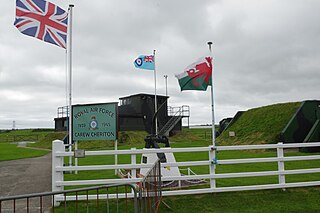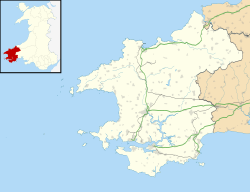
Rapier is a surface-to-air missile developed for the British Army to replace their towed Bofors 40/L70 anti-aircraft guns. The system is unusual as it uses a manual optical guidance system, sending guidance commands to the missile in flight over a radio link. This results in a high level of accuracy, therefore a large warhead is not required.

Anti-aircraft warfare, counter-air, AA guns or air defence forces is the battlespace response to aerial warfare, defined by NATO as "all measures designed to nullify or reduce the effectiveness of hostile air action". It includes surface based, subsurface, and air-based weapon systems, associated sensor systems, command and control arrangements, and passive measures. It may be used to protect naval, ground, and air forces in any location. However, for most countries, the main effort has tended to be homeland defence. NATO refers to airborne air defence as counter-air and naval air defence as anti-aircraft warfare. Missile defence is an extension of air defence, as are initiatives to adapt air defence to the task of intercepting any projectile in flight.

The de Havilland DH.82 Tiger Moth is a 1930s British biplane designed by Geoffrey de Havilland and built by the de Havilland Aircraft Company. It was operated by the Royal Air Force (RAF) and other operators as a primary trainer aircraft. In addition to the type's principal use for ab initio training, the Second World War had RAF Tiger Moths operating in other capacities, including maritime surveillance and defensive anti-invasion preparations; some aircraft were even outfitted to function as armed light bombers.

Number 216 Squadron is a squadron of the Royal Air Force based at RAF Waddington, Lincolnshire, since reforming on 1 April 2020 and is tasked with testing future drone swarm technology. It had previously operated Lockheed TriStar K1, KC1 and C2s from RAF Brize Norton, Oxfordshire, between November 1984 and March 2014.

Holbeach Air Weapons Range is a United Kingdom Ministry of Defence academic air weapons range (AWR) situated between Boston and King's Lynn in the civil parish of Gedney on The Wash, in Lincolnshire, eastern England.

Pembrey Sands Air Weapons Range is a Ministry of Defence air weapons range located near the village of Pembrey, Carmarthenshire, 3 miles (4.8 km) northwest of Burry Port and 10.3 miles (16.6 km) south of Carmarthen, Wales. Adjacent to the weapons range site is a former Royal Air Force station known as Royal Air Force Pembrey, or more simply RAF Pembrey, which closed in 1957 and of which part is now in civilian use as Pembrey Airport.

RAF Andover is a former Royal Flying Corps and Royal Air Force station in England, 2 miles (3.2 km) west of Andover, Hampshire. As well as RFC and RAF units, units of the Aviation Section, U.S. Signal Corps, Royal Canadian Air Force, United States Army Air Forces, and the Air Transport Auxiliary were also stationed at the airfield.

Royal Air Force Brawdy, or more simply RAF Brawdy, is a former Royal Air Force satellite station located 6.3 miles (10.1 km) east of St Davids, Pembrokeshire and 9.8 miles (15.8 km) south west of Fishguard, Pembrokeshire, Wales. It was operational between 1944 and 1992; it was used by the Royal Air Force and the Royal Navy (1946–1971), before the site was turned over to the British Army and renamed Cawdor Barracks.

Llanbedr Airport, formerly RAE Llanbedr, is an operational general aviation airport located in the Snowdonia National Park near the village of Llanbedr, Gwynedd, northwest Wales.

Royal Air Force Watton or more simply RAF Watton is a former Royal Air Force station located 9 mi (14 km) southwest of East Dereham, Norfolk, England.
RAF Cleave is a former Royal Air Force station located 4.2 miles north of Bude in Cornwall, United Kingdom, which was operational from 1939 until 1945. Despite a few periods of intense activity, it was one of Fighter Command's lesser used airfields.
Royal Air Force Angle, or more simply RAF Angle, is a former Royal Air Force station located on the Angle Peninsula Coast, 8 miles (13 km) west of Pembroke, Pembrokeshire, Wales. It was operational from 1 June 1941 to 11 July 1946, having been used by both the Royal Air Force and the Royal Navy.

Royal Air Force Carew Cheriton, or more simply RAF Carew Cheriton, is a former Royal Air Force station located near Carew, Pembrokeshire. It was situated 4.7 miles (7.6 km) north west of Tenby.

Royal Naval Air Station Dale is a former Royal Naval Air Station, located 10 miles (16 km) South West of Haverfordwest in Pembrokeshire, Wales. It was operational between 1942 and 1948, being used by both the Royal Air Force (1942–1943) and the Royal Navy (1943–1948).
Royal Air Force Templeton, or more simply RAF Templeton, is a former Royal Air Force station located 9.75 miles (15.69 km) south east of Haverfordwest, Pembrokeshire and 10 miles (16 km) north east of Pembroke Dock, Pembrokeshire, Wales.

Royal Air Force Towyn, or more simply RAF Towyn, is a former Royal Air Force airfield located 10.3 miles (16.6 km) west of Machynlleth, Powys and 12.2 miles (19.6 km) north of Aberystwyth, Ceredigion, Wales.

Royal Air Force Wrexham, or more simply RAF Wrexham, is a former Royal Air Force station at Borras, on the outskirts of Wrexham, Wales and north-east of the city centre.

RAF Weybourne was a Second World War anti-aircraft establishment. 'X' Flt, No 1 Anti-Aircraft Co-operation Unit were based at the station between 16 May and 14 September 1939, with 'T' Flt, No 1 Anti-Aircraft Co-operation Unit there between 25 February and 29 April 1942. No 6 Anti-Aircraft Co-operation Unit were based there between 7 December 1942 and 30 November 1943.

Castlemartin Training Area is a British Army military training area and armoured fighting vehicle range located in the Welsh county of Pembrokeshire. It was originally established for tank training by the Royal Armoured Corps in 1938. The training area is located within the Pembrokeshire Coast National Park, on the South Pembrokeshire coast.

The Joint Ground Based Air Defence Headquarters or JtGBAD HQ was a joint (non-deployable), force-generating British military formation under the operational command of RAF Air Command, sitting under No.1 Group. It was formed circa 2000 and disbanded in 2019 in favour of 7th Air Defence Group.






















